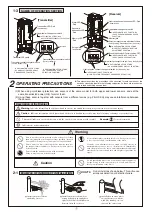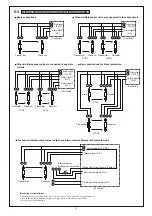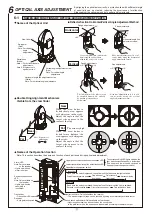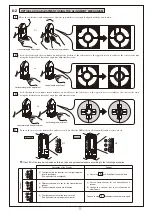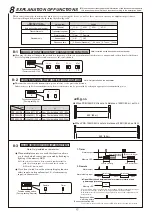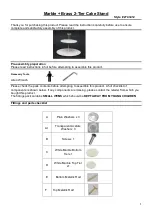
–10°
+10°
Rough adjustments
+90°
+5°
–90°
–5°
–10°
+10°
Names of the Operation Section
Note: This section describes the name and function of each part used during optical axis adjustment.
Upper transmission/reception authorization LED
Lower transmission/reception authorization LED
Each time the switch is pressed, the optical unit that transmits the light switches.
Transmitter
Receiver
Upper/lower changeover switch
Swing arm
(Red)
Note: For vertical
angle
adjustments
Horizontal angle fine adjustment screw
(White)
Note: For horizontal angle adjustments
Vertical angle adjustment screw
(Red)
Note: For vertical angle
adjustments
Swivel base
(White)
Note 1: For horizontal angle
adjustments
Note 2: Single notch is
equivalent to 3°
Near
Far
Note: Sequence of
adjustment
Near
Far
When the view finder is
looked closely, view appears
as the diagram on the right.
Adjust the angle so that the
target color appears in the
center of the ring.
When the view finder is
looked from a distance, the
view appears as the diagram
on the right.
Adjust the angle so that the
target color appears in the
center of the ring.
(The accuracy high)
Double Ring Alignment Mechanism
Visible from the view finder
6-1
NAMES AND FUNCTIONS OF OPTICAL AXIS ADJUSTMENT PARTS
OPTICAL AXIS ADJUSTMENT
Names of the Optical Unit
View finder
Horizontal
Reflector Section Horizontal/Vertical Angle Adjustment Method
Vertical
Coarse adjustments can be made
by moving the swivel base
within the range of 0˚ to ±90˚.
Next, fine adjustments of 0˚ to ±5˚
can be made using the horizontal
angle adjustment screw.
Fine adjustments
Horizontal angle fine
adjustment screw
Rough adjustments
Fine adjustments
The inclination of the reflector can
be switched between -10˚ and +10˚
by pushing it forwards or
backwards.
Next, fine adjustments of 0˚ to ±10˚
can be made using the vertical
angle adjustment screw.
6
By aligning the optical axis correctly, a protection line with sufficient margin
of sensitivity can be created, reducing the occurrence of malfunction.
Always adjust the optical axis on both upper and lower levels.
Alarm LED
Note: Only available
on the receiver
• Lights up when an
alarm is output.
Sensitivity attenuation
LED
Note: Only available on
the receiver
• Lights up when the
sensitivity is
insufficient.
The corresponding LED lights up when the
light transmission/reception is authorized.
(The upper and lower can be switched by
he upper/lower changeover switch.)
Transmit from both upper and lower
Only transmit
from upper
Only transmit
from lower
No transmission
Received on both upper/lower
Only received on lower
Only received on upper
Each time the switch is pressed, the optical unit that receives the light is switched.
Monitor jack Note: Only available on the receiver
• The monitor output voltage can be checked by using a commercially available tester.
Transmitter:
• Transmitter LED switch
Receiver:
• Auto gain lock switch
Sound check switch Note: Only available on the receiver
• Light reception level can be checked by the sound tone.
In the walk test mode, the beep sound is generated according to the alarm output.



